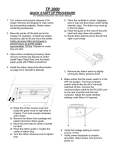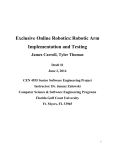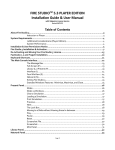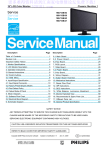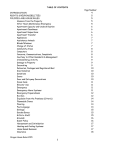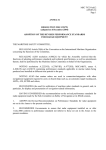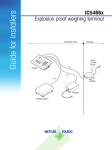Download Developing a Working Model: - SMARTech
Transcript
Developing a Working Model: Interim Report of Grove Mowing Operations Technical Report HFA-TR-0902 Atlanta, GA: Georgia Institute of Technology School of Psychology – Human Factors and Aging Lab April 2009 Ralph H. Cullen, Daniel Serrano Baquero, Jenay M. Beer, Sara E. McBride, Cory-Ann Smarr, Wendy A. Rogers, & Arthur D. Fisk 1 TABLE OF CONTENTS EXECUTIVE SUMMARY................................................................................................................................... 4 INTRODUCTION ................................................................................................................................................ 6 ESTABLISH KNOWLEDGE ENGINEERING GOALS.................................................................................... 8 FAMILIARIZATION WITH PRODUCT LITERATURE ................................................................................. 9 GROVE LEVEL LITERATURE.............................................................................................................................. 9 TRACTOR LEVEL LITERATURE ........................................................................................................................ 10 SUMMARY OF DOCUMENTATION REVIEW ....................................................................................................... 11 SYSTEM ANALYSIS......................................................................................................................................... 11 STAKEHOLDERS............................................................................................................................................... 11 ENVIRONMENT ................................................................................................................................................ 12 TASKS .............................................................................................................................................................. 13 SUMMARY OF SYSTEM ANALYSIS .................................................................................................................... 14 SUBJECT MATTER EXPERT INTERVIEWS ................................................................................................ 15 MOWING IN A GROVE ...................................................................................................................................... 16 Environmental Conditions ............................................................................................................................ 16 Maintenance and Upkeep ............................................................................................................................. 16 Training....................................................................................................................................................... 17 JOHN DEERE 6430 PREMIUM ........................................................................................................................... 17 Command Center ......................................................................................................................................... 17 Application and Uses of 6000 Series ............................................................................................................. 19 Additional Insights ....................................................................................................................................... 19 SUMMARY OF SUBJECT M ATTER EXPERT INTERVIEWS ................................................................................... 20 2 GENERAL DISCUSSION ................................................................................................................................. 20 KEY RESULTS .................................................................................................................................................. 22 NEXT STEPS ..................................................................................................................................................... 22 APPENDIX ......................................................................................................................................................... 23 AUTHOR NOTE ................................................................................................................................................ 31 3 EXECUTIVE SUMMARY The goal of this project is to develop an in-depth understanding of knowledge, skills and operations required for mowing in orange groves. The objectives are to provide an assessment of the cues used by the operators, the information requirements, and the communication processes critical for successful operation. This assessment will provide guidance for development of autonomous systems as well as for redesign and training for current systems. Our approach to this evaluation is a knowledge engineering study of a John Deere 6000 series utility tractor in grove mowing application, specifically the 6615 and the 6430 Premium utility tractors. By using the knowledge engineering process, we will understand the “knowledge” of system users in the context of the operational environment. Knowledge refers to the general information that users have about the system, their methods and procedures for using the system, and the information in the environment that they rely on to use the system safely, efficiently, and effectively. As such, the knowledge engineering process can be used to improve existing systems, to develop better training and instructional materials, to identify usability problems, to understand user needs and preferences, and to guide the development of future systems (e.g., by automating functions currently performed by humans). Overview of our Approach The necessary first step of the knowledge engineering process is to create a “working model” of the system, which involves developing a detailed understanding of the design and operation of the current machine. This information provides the basis for the development of structured interviews to elicit knowledge from operators. Review available documentation. We first reviewed the product literature pertaining specifically to the tractors as well as information about the grove context in which the mowing takes place. Materials included the manuals, product specification sheets, grove descriptions, tractor illustrations, and grove pictures. The grove literature provided information about mowing 4 operations in that context and an overview of the factors that affect mowing. The tractor documentation provided details about the functioning of the tractors; how each tractor was operated, what each tractor could do, and differences between the two models. Conduct system analysis. We conducted a system analysis wherein we identified major components of the mowing application including major stakeholders, environmental factors, and system tasks. The interests of the stakeholders were identified to determine system expectations. Environmental factors were considerations that might influence tractor operation during mowing (e.g., ground stability, presence of obstacles). Tasks were divided into grove level tasks (e.g., determine tractor route), tasks internal to the tractor (e.g., steering), and tasks external to the tractor (e.g., attach implement). These analyses were used to create scripts for the subject matter expert interviews. Subject matter experts were drawn from the following categories: dealers, marketing specialists, tractor owners/operators, and grove supervisors. These individuals were interviewed to gather detailed information about the 6615 and the 6430 Premium utility tractors and their operation. The focus of the interviews was on the functions of the tractors that were highlighted during marketing and sales; positive and negative characteristics of the tractor from the perspective of the owner/operator; the nature of the mowing task within the grove; and the characteristics of typical operators. This report provides a summary of the product analysis, the system analysis, and the results of the subject matter expert interviews. These analyses were used to develop the operator interviews, which were conducted in April 2009. Those data are currently being analyzed and will provide detailed information about the cues used by the operators, the information requirements, and the communication processes critical for successful operations. 5 INTRODUCTION The goal of this project is to develop an in-depth understanding of knowledge, skills, and operations required for mowing in orange groves. The objectives are to provide an assessment of the cues used by the operators, the information requirements, and the communication processes critical for successful operation. This assessment will provide guidance for development of autonomous systems as well as for redesign and training for current systems. This report provides a summary of the product analysis, the system analysis, and the results of the subject matter expert interviews. These analyses were used to develop the operator interviews, which were conducted in April 2009. Those data are currently being analyzed and will provide detailed information about cue use, information requirements, communication processes, and task sequencing. To accomplish our goal, we used the knowledge engineering process. One of the most important sources of information when designing a product is the users. Users can provide valuable information regarding what a new product should do, what it should look like, and how it should work. Information taken from users, however, is very difficult to analyze; different users have different opinions, experience with the product changes opinions on how to use it, and methods for the users to report their likes and dislikes are often poorly prepared and controlled. Knowledge engineering has been defined as a viable process to gather information from users; it provides a structure and method in which the users’ comments and suggestions can be integrated into what is already known about the system design to provide both constructive feedback on problems with the system and an action plan going forward to inform future design. A detailed description of the knowledge engineering process can be found in Bowles, Sanchez, 6 Fisk, and Rogers (2004).1 Figure 1 provides an overview of the knowledge engineering process. Establish Knowledge Engineering Goals Familiarization with Product Literature Subject Matter Expert Interviews Detailed Task Analysis Construct the Test Instruments Knowledge Extraction Tools Prepare to Collect Data Analyze and Interpret the Data Collect Data Develop a Working Model Extract Knowledge Structure Knowledge Figure 1. Overview of the Knowledge Engineering Process (from Bowles et al., 2004). We divide knowledge engineering into four major phases: The first phase, Establish Knowledge Engineering Goals, focuses directly on specifying the purpose of the knowledge engineering product. In this phase, we define the system in question and develop the goals for informing or improving that system. It is important to note that, in the context of knowledge engineering, the “system” refers to both the human operator and the machine. This approach, where the two are considered as a whole, allows for the optimization of the whole system and not just one part at the expense of the other. 1 Bowles, C. T., Sanchez, J., Fisk, A. D., & Rogers, W. A. (2004). A primer for knowledge engineering (HFA-TR-0402). Atlanta, GA: Georgia Institute of Technology, School of Psychology, Human Factors and Aging Laboratory. 7 The second phase, Develop a Working Model, centers on gathering the background information of the system. At the end of this phase, it is critical for the project team to be extremely knowledgeable concerning the original system and problem space in which the evaluation will focus. This report focuses primarily on these first two phase of the knowledge engineering study of the grove mowing operation. We briefly summarize the knowledge engineering goals established by the Deere & Company and Georgia Tech personnel. We then provide a summary of the product analysis, the system analysis, and the results of the subject matter expert interviews. We analyzed the mowing application of two models of the John Deere 6000 Series: the 6615 and the 6430 Premium utility tractors. These analyses were used to develop the operator interviews, which were conducted in April 2009. The interview data are being analyzed and will be presented in the final report in the context of the remaining phases of the knowledge engineering process: Knowledge Elicitation and Structuring the Knowledge. ESTABLISH KNOWLEDGE ENGINEERING GOALS The goal of this project is to develop an in-depth understanding of the operations involved in the use of tractors in orange groves. The objectives are to provide an assessment of the cues used by the operators, the information requirements, and the communication processes critical for successful operation. This assessment will provide guidance for development of autonomous systems as well as for redesign and training for current systems. This context provided the basis for the knowledge engineering goals for this study. After review of the problem space, we decided to first focus on the general task of mowing in orange groves. The next step will focus on spraying which consists of different specific task operations. Moreover, we decided to focus on a class of orange groves (fairly large 8 size, located in the Southeast). Additional research will be needed to determine the generalizability of the present findings across use contexts. FAMILIARIZATION WITH PRODUCT LITERATURE Familiarization with product literature has two purposes: First, it identifies possible sources of data for the system analysis. Together with the in-depth system analysis, the familiarization with product literature forms the foundation for the questions and conversations of the subject matter expert interviews. Second, it informs the knowledge engineering team about the system. Obviously; without a working knowledge of all parts of the system, the team will have difficulty progressing through the system analysis. For this project, we reviewed the literature available for both the grove and the tractor as related to the mowing application. Thus, we divided our review into grove level literature and tractor level literature. Grove Level Literature We reviewed various materials to understand the groves including: aerial grove maps; pictures of grove rows and buildings; descriptions of grove dynamics and equipment; schematics of grove blocks and rows; and articles pertaining to mowing in a grove. Grove mowing is a complex task involving a series of machine-operator teams working simultaneously throughout the year. Mowing is important to allow efficient fertilizer spraying and to make harvesting easier on the grove workers. Managers and supervisors must plan placement of each tractor-operator team to ensure grass is maintained at an acceptable level. Operators have to deal with varying stimuli, including different types of rows, environmental conditions, and obstacles. 9 Understanding the dynamics of the environment in which the mowing application takes place is critical. This knowledge guided many of our questions to subject matter experts concerning the capabilities and limitations of the tractor specifically in the work context of the grove. Tractor Level Literature To attain information concerning the capabilities and limitations of the tractor, we examined the tractor specifications and manuals provided by Deere & Company. Two models of tractor were analyzed. To understand exactly what operators see, hear, and do as they mow within a grove we analyzed the John Deere 6615 model tractor. This tractor, however, is not only discontinued in the Deere product line, but also lacks the electronic support for further developments down the line. Therefore, the John Deere 6430 Premium model tractor was also analyzed. The 6430 has increased technological functionality and there are applications and extensions of that technology in the future product development. We gained an understanding of both tractor models’ operation including driving and operating the implements. For the 6430 Premium, special care was given to understanding the intricacies of the Command Center module. Differences in Figure 2. Sample cataloguing of display icons. operation between the two 10 models were identified. All displays and controls in each model were identified and labeled (see Figure 2 for an example). We are preparing a detailed usability assessment of the 6430 Premium, including the Command Center module, which will be available in a separate report. Summary of Documentation Review An analysis of the grove documentation provided an understanding of the environmental and physical context in which mowing takes place. Reviewing the tractor literature for both the 6615 and 6430 tractors supported our understanding of how operators might perform the task of mowing using these tractors, including the information they must process as well as the actions they must take. By incorporating these two sets of knowledge, we were able to ask the subject matter experts more specific questions about how each tractor would accomplish the task of mowing in a grove application. SYSTEM ANALYSIS We analyzed the human-machine system (6615 and 6430 Premium tractors) within a grove mowing work context. This analysis allowed us to gain understanding about stakeholders and their expectations, mowing tasks, and environmental factors involved in a mowing application. Stakeholders The stakeholders in a system are all the individuals who interact with and are affected by the activities carried out in the system, in this case, the activities carried out in a mowing application. Identifying the stakeholders and their goals in a system allowed us to identify what the success and quality criteria were for the system. The identified system stakeholders and their 11 goals are outlined in Figure 3. For the system to operate at an optimal level, Deere & Company and its dealers are most interested in providing quality in their products and support to help throughout the life of those products (although note that all the lower-level goals are also presumed to be relevant to Deere & Company). The farmers and supervisors are most interested in efficiency and consistency, as these two variables translate most directly to cost and profit. Efficiency and consistency refer to both operators using the tractors to mow the grove and the tractors themselves; removal of either or both will occur if a more cost-effective solution is available. An efficient and consistent operation also requires the least maintenance and upkeep and therefore less consumption of capital. The operators have the more immediate goals of completing the requisite mowing, minimizing accidents and injuries in the process. Figure 3. The shareholders and their interests and goals. Environment The operational environment refers to the context and physical space in which the mowing task would take place. Table 1 shows the identified environmental factors. 12 Documentation about locations and conditions in the grove as well as pictures of the grove and surrounding areas revealed that the mowing task occurs in a variety of situations which are affected by different sets of environmental factors. Each factor affects the expected performance or outcome of certain parts of the mowing task. For example, at the tractor level, rain, fog, or night mowing conditions would lower the visibility of the operator, changing the way that operator had to mow to avoid making mistakes. These factors can also affect the mowing operation at the grove level; certain conditions affect how routes and tractors or assigned, and even whether or not mowing will happen on that particular day. Table 1. Environmental Factors Affecting Mowing Factor Considerations Ground material Concrete (street), dirt, or sand Ground stability Firm or loose Incline Flat or sloped Light Day or night Navigation Forward, backwards, sharp turns Obstacles Animals, people, rocks, water, pumps, equipment Temperature Hot or cold Type of row Bed or swale View Clear or fog/sand/spray Weather conditions Windy or calm, rain or sunshine Tasks Tasks are specific actions taken to accomplish the goal of mowing. Tasks were identified according to three categories: grove-level tasks, tasks internal to the tractor, and tasks external to the tractor (see Table 2). This list is not exhaustive; rather it provides an initial understanding of the range of tasks performed by the system. The tractor level tasks were organized into internal and external tasks depending on where the interaction took place, internal or external of the cab. 13 This distinction does not refer to the location of the operator; rather it describes the focal point of the task. For example, the external task of checking the environment is performed both inside and outside of the cab, but the focus is on stimuli outside the cab. Table 2. Initial Set of Tasks Grove Level Tasks Determine daily mowing goals Evaluate tractor and implement conditions Evaluate grove conditions Evaluate environmental conditions Determine tractor route Evaluate operator performance Internal Tractor Level Tasks Start/stop motor Adjust/turn steering wheel/steer Maintain/change speed (accelerate/decelerate/brake) Maintain/change direction (reverse) External Tractor Level Tasks Get tractor/implement from storage Prepare tractor/implement (from/for storage) Store tractor/implement Attach/detach implement Adjust environmental conditions (open window, AC) Perform pre-driving check Enter/exit tractor Monitor sensory feedback (auditory, tactile, olfactory, etc.) Open/close door/window Store/Retrieve (food/cell phone/laptop etc.) Adjust hydraulic system Monitor engine settings Monitor fuel consumption Engage/disengage PTO Shift View implement Pull implement View & avoid obstacles Fuel tractor Perform pre-driving check Perform routine maintenance Perform need-based maintenance View street/equipment/obstacles Monitor external feedback Summary of System Analysis The primary outcomes of the system analysis were identification of the stakeholders and their goals; the important environmental factors to consider; and an initial list of the primary 14 tasks relevant to the context of mowing in orange groves. These findings provided the basis for the development of the subject matter expert interviews. SUBJECT MATTER EXPERT INTERVIEWS We used the outcome of the system analysis with the product and grove literature reviews to develop the subject matter expert interviews. We selected individuals to represent the different categories of stakeholders and based on their understanding of different parts of the system. During two dealer visits, we interviewed the following subject matter experts: two dealer sales representatives, a dealer technology expert, a dealer maintenance expert, an owneroperator, and two employees of an owner-operator. We also conducted telephone interviews with a grove manager, a grove supervisor, and a Deere marketing specialist. All interviews were conducted orally with notes taken concurrently by the interviewers. The conversations focused on the John Deere 6000 tractor series. The questions asked to all experts came from lists created before the interviews. These lists are provided in the Appendix with samples provided in Table 3. Each interview began with open questions meant to elicit discussion and to build a rapport with the experts. As the interview proceeded, we asked questions that were more specific to clarify points made by the expert, to elicit elaboration on a topic, or elicit further discussion. The analysis and conclusions drawn from the interviews of the subject matter experts are reported as general themes. These themes represent common topics or ideas observed across multiple interviews. The themes are derived from a bottom-up coding (coding based on the words and phrases the expert used, not on which questions the expert was answering) of the combined interviews. 15 Table 3. Sample Interview Questions Supervisor/Manager Questions Could you walk us through a typical day for the mowing crew? How do the mowing crews learn the safety information? Who were the mowing crew trained by? Sales/Training/Customer Questions How do you match the product to the customer and their needs? How do customers learn to use the tractor? What is the first thing you do daily to start operation? Maintenance Questions What are the most common problems with this model? What are the most critical problems with this model? How do you solve common maintenance problems? Mowing in a Grove Environmental Conditions The interviews focused on information concerning use of the tractor when mowing in a grove. Information about the types of operators using the 6000 series tractors in grove mowing applications, concerns and problems those operators might encounter while mowing, and type of environments the 6000 series tractors would be operated in was collected from the interviews. For example, we learned that, due to the specific environmental conditions of the grove, certain problems that may be generally important (extreme cold, snow) were not relevant to this particular mowing context. Other factors more pertinent would be sandstorms and early morning fog. Maintenance and Upkeep Recurrent problems and troubleshooting steps differed between dealers and the groves. Many of the differences between the grove operation and the prescribed operation by the manuals and dealers came in the form of internal standards, safety checklists, and maintenance 16 routines. The groves also had a different work culture, where the importance of certain issues differed between operators and supervisors and supervisors and grove managers. Training Deere & Company exceeds other companies by the amount of after-sales support they provide to customers. In fact, the after sale-support was reported as one of the main reasons customers return to Deere & Company dealerships for all of their tractor needs. Oftentimes, after a sale, the customers receive information regarding the user manual, general maintenance procedures, and other critical information. However, the majority of the customers are not the actual operators of the tractor. Dealers do not often interact with the actual operators. It was reported that most operators of 6430 series (and many other tractors) never received any formal training. Most learned how to operate a tractor from a family member or friend as a young child, or by having to pick up the operation while on the job. This lack of formal training could explain any differences we might find between the actions the manuals or supervisors suggest to take when driving the tractor and those actually taken by the tractor operators. John Deere 6430 Premium Command Center In addition to receiving much information about the task of mowing in a grove, we also gathered information concerning the John Deere 6430 Premium series. More specifically, we identified two main themes about the Command Center. First was the lack of general acceptance of the Command Center digital platform. The Command Center was hard to market, sell, and understand for a variety of reasons. The experts reported that the customers lacked a full understanding of the features and potential benefits of the Command Center. 17 The interviews indicated that how the Command Center aids in the use of the tractor and why it might have benefits over the manual control models are not clearly understood. This may be attributed to the difficulty in learning how to operate the system. Compounding this issue, the dealer personnel have a lack of training on the Command Center, which translates to a lack of understanding of its functions and a hardship in conferring the usefulness of those functions to the customers. These problems ranged from the very complicated (not understanding how to operate the headland management system) to the very simple (confusion in how to set the clock or turn on the headlights). Customers generally know what tractor they want to purchase before going to the dealership. However, they may not know what specific features they would want on the tractor. It is important for the dealer to understand the needs of the customer, to match the correct tractor (with the correct features) to the customer. An inability of dealers to explain the functionality of the Command Center makes it harder to promote its benefits to customers. However, in general the dealers and customers seemed to prefer simple tractors to the more complex ones, going so far as to laud Deere & Company’s new base model selections as preferable over the more technologically advanced options as a step in the right direction. Other added benefits and functionality of the premium model are emphasized or marketed (e.g., , improved hydraulics, transmission options, ergonomic features of the upgraded cab), to sell the 6430 Premium series over the base model, often ignoring or glossing over the Command Center. General comments by several SMEs, such as “John Deere is becoming too technologically advanced” or “too far ahead,” highlighted the common discomfort surrounding the application of new technology to tractors, such as the 6430 Premium Command Center. 18 The second common theme related to the John Deere 6430 Command Center was the general view that the added functionality the Command Center provided was not needed given the specified size and applications for which the 6430 was suited. This echoes the sentiment mentioned earlier; that a utility tractor with the wheel base and horsepower of the 6000 series would not be suited for any job that would require the level of digitalization that the Command Center provided. The feeling prevailed that although larger tractors and farming implements had reason to include this added functionality, the 6430 would function just fine without it. Application and Uses of 6000 Series To better understand the themes of problems related to the 6430, we delved deeper into where the 6430 was being sold and who was using it. The main applications of the 6000 series tractors in the areas we visited were for small vegetable or hay-baling operations. The larger operations such as row crops used larger tractors with bigger wheel bases and more horsepower. Oftentimes, the 6000 series tractor was used more as a towing vehicle than with any sort of PTOpowered implement on the back. Given the agricultural demographics of the areas we visited, the lack of complex applications suited for the 6430 was another stated reason for the disuse of the advanced features of the Command Center. These observations and themes relate to the SMEs currently interviewed for this project; we do not wish to imply that the 6430 is only used in these applications. Additional Insights There were also other comments about the Deere 6430 Premium, such as the dislike of the placement of the gas cap, the lack of a large fender, and the lack of sun shade inside the cabin. The added hydraulic power and more comfortable cab, however, were seen as good selling points. The quick access buttons were seen as a good alternative to manual control, and 19 the added lights and gas mileage were lauded. The most positive comments we received, however, were about Deere & Company’s commitment to service and support after sale. Summary of Subject Matter Expert Interviews Concerning the overall goal of this project, a major purpose of the subject matter expert interviews was to supplement our familiarization with product literature. The current interviews offer an initial examination of what might affect system operation, both negatively and positively. The interviews conducted with individuals who focus on grove operations provided a way to check and edit the information we aggregated from previous sources. These interviews also allowed us to focus on certain confusing aspects of the operations at the grove so that those aspects could be explained and placed into the correct context of the entire system. The interviews with people who sell and maintain the tractor provided a wealth of information about the current state of the John Deere 6430 in context. Those interviews provided information about who buys the tractors, what the tractors are used for, common issues concerning the tractor, and what the best features seem to be. Both at the grove and tractor levels, the subject matter expert interviews identified the best-working aspects of the system but also possible realms of improvement. All the information gathered here is critical for completing the Knowledge Engineering process. GENERAL DISCUSSION Although developing a working model is only one phase of the Knowledge Engineering process, it is useful tool in and of itself. At the beginning of this process, the goal was to understand “how the mowing process worked.” At the end of the process, there were three 20 products that all serve an important purpose, not only to carrying out the latter phases of Knowledge Engineering, but as a resource for any further instances of the mowing application. Together, the literature review, systems analysis, and subject matter expert interviews create a detailed picture of how the current system works. The familiarization with product literature successfully gave the team a general idea of the scope and components of the system. This led to an understanding of what the system included, the major players in the system (both human and machine), pictures and diagrams of the machines and environments in the system, and what parts of the system needed further analysis. This knowledge guided the system analysis and subject matter expert interviews by informing the team about the entire human-machine system. The system analysis focused around the two realms defined in the literature review, the grove level and the tractor level. In each level, three different components were identified: the stakeholders, the environmental factors, and specific tasks. The results of the system analysis are summarized in Figure 3 and Tables 1 and 2. With the system analysis finished, it is easier to compare data from different users or to compare new systems to the current state of the system. The system analysis also helps to develop the questions and focus areas of the subject matter interviews. The subject matter expert interviews supplemented the information obtained from the literature review and system analysis. The interviewees validated, refined and, in some cases, corrected that information with their knowledge of the current system. The interviews also added information regarding how certain tasks were performed, how environmental stressors affected the tractor or mowing, and how operator training affected task procedures. 21 Key Results The key outcomes of this phase of the Knowledge Engineering analysis of a mowing application of the John Deere 6000 Series are: Many factors influence the way a tractor is used (i.e., tasks, environment, stakeholders’ concerns). These factors must be considered to fully understand the human-machine system. The three different types of stakeholders (Deere & Company and its dealers; owners and supervisors; and operators) have different specific motivations but still share the same overarching interests of high quality and performance in a tractor. After-sales support was reported as an important reason customers return to Deere dealerships for all of their tractor needs. In general, it is more probable than not that the digital platform of the 6430 tractor, the Command Center, is not well understood by users, which leads to its underutilization. Next Steps This report provides a summary of the product analysis, the system analysis, and the results of the subject matter expert interviews. These analyses were used to develop the operator interviews, which were conducted in April 2009. Those data are currently being analyzed and will provide detailed information about the cues used by the operators, the information requirements, and the communication processes critical for successful operations. Specifically the operator interviews will enable us to: provide detailed information about information requirements for mowing; identify how operators plan and sequence tasks; characterize use of cues; and determine decision making process. This assessment will provide guidance for development of autonomous systems as well as for redesign and training for current systems. 22 APPENDIX SUBJECT MATTER EXPERT INTERVIEW SCRIPTS CUSTOMER QUESTIONS Background Can you tell us a little about what you do? o What operation/application is the tractor used for? o How large is this application? General use When did you purchase the 6430? What was it about the 6430 that made you decide to purchase it? How does the 6430 operate compared to previous tractors you have used? *Are those previous tractors all John Deere, or other brands?Are you the primary user of the tractor or is it usually used by your employees? When you use this for X application, walk us through your step-by-step process for using the tractor? We want to you take us through a typical work day with this tractor. o What is first thing you do daily with 6430 to start operation? o What implements are used? Where are they stored? How/when are they hooked up? o What is the end-of-day procedure for shutting down the tractor and preparing it for storage? Maintenance What are most common maintenance problems? What is your regular maintenance schedule? How do you solve common maintenance problems? For your specific operation (hay), what maintenance problems could completely shut down operation o Have you had any of these problems since you purchased the 6430? How often do these critical problems occur? o When/if they do occur, how are they problems resolved? Training How did you learn how to use the 6430? How did your employees learn to use the 6430? How much did the Dealer help you learn to use the 6430? Do you wish you had received any additional information or instruction about the tractor? Functionality Do you feel like you use most of the functions available on the 6430? Are there any functions that you wish the 6430 had? Are there any functions on the 6430 that do not work as you expected? If you were designing the perfect tractor for your needs, what features and functions would you want it to have? 23 DEALER QUESTIONS Sales Imagine I am a customer, what would you ask me? What are the first things you tell the customer? How do you match the product to the customer and their needs? What questions do you ask the customer to understand their needs? Walkthrough What is the most common tractor you sell? For that tractor, what model features do you emphasize? Which features of this tractor do you have difficulty explaining? What features are difficult for customers to understand? What are common questions that customers ask? Do you sell many 6430s? How do your answers to the previous questions vary when thinking about the 6430 compared to other tractors? Special/Critical Features of the 6430 What model features do customers really like? What are the primary tasks the 6430 used for? What can John Deere’s 6430 do that other companies’ tractors cannot? Customers Who are your typical customers? How big are the farming operations? How many tractors does a typical customer have on their property? Who buys what kinds of tractors? Do you interact directly with farm owners, supervisors, or tractor operators? o Is this typically the same person who operates the tractor? How knowledgeable about tractors in general are they when they come in? How about for the 6430 model? Post-Sales Training What happens after a customer purchases a tractor? Is it delivered to the property? Is there any kind of demonstration or training that occurs upon delivery? How do customers learn to use the tractor? Does this differ across tractors? How much of the initial set-up and programming of the tractor are you involved in? What kinds of services or materials are available to help customers learn? Does Deere provide materials they want you to use to train customers? Who do you train (operators, supervises, buyers, etc.)? When tractors are upgraded, how do customers learn how to use them? What training is needed if a customer transfers from one company to a John Deere tractor? How does this differ for the 6430 model? Maintenance What are the most common maintenance problems that customers report? What are the most critical maintenance problems that customers report? Are some problems so critical that the tractor must be taken out of service? 24 How do you solve the problem? o Probe: If the answer is “it depends”, what does it depend on? Where are problems solved? Do customers try to solve problems themselves or do they bring their tractor in to be fixed? Is there a regular maintenance schedule? How does this vary for the 6430 model? Dealers How did you learn about these tractors and their functions? What kind of training (manuals, seminars, etc.) did you get about the tractors and their functions? What kind of materials do the dealers get? General information about the dealership: o Size o # of tractors sold per year 25 GROVE MANAGER QUESTIONS Equipment - What type of transmission are the tractors equipped with ? - Is AutoSteer equipped in the tractors Getting ready to mow - In the grove, how do you decide what pattern of rows to mow? o If not you, who determines the mowing pattern (supervisor?) Mowing - How does mowing work o Beds and swales o Which one follows which one o 10ft and 15ft mowers o People involved 26 GROVE SUPERVISOR QUESTIONS Background What are your job title and responsibilities? o What are you responsible for from day-to-day? o Who is your supervisor? Someone you have to report to? o Who do you supervise? How many people do you oversee? o Are there other grove managers at your level? How is that different from other supervisors? Who tells the mowing crew what to do? What tractors does Devil’s Garden Grove use for mowing? o What do they use most often? o Are any of these premium models? o Do you know if they come equipped with Command Centers? o How long has the mowing crew been using this tractor? Are the same tractors used across groves or do they vary by grove? o If they vary, are there major differences between the tractors? o Do the tractors travel with the mowing crew? Do you have experience operating the tractors used for mowing? o If so, how often? Who owns the tractors? o Southern Gardens Citrus or Devil’s Garden Grove? Are members of the mowing crew employed by the Southern Gardens Citrus or Devil’s Garden Grove? o How large is the mowing crew? o How does Southern Gardens Citrus (or Devils Garden Grove? See answer above) hire the mowing crew? o What are the nationalities of the mowing crew? Are they primarily from Central America, South America, etc.? o What is their primary language? What language do they speak on the job? What language do the supervisors use when interacting with the mowing crew? How do the supervisors and mowing crew communicate? Is language a barrier to training or instructing the mowing crew? o What is the range of age of your mowing crew? o What is the average age of your mowing crew? o What is the most common level of education your mowing crew has? o What is the range in education level? o What is the turnover rate for your mowing crew? o What is the average level of experience held by the mowing crew? o How long is the average workday? How many hours are spent mowing? How many days/hours a week? 27 If it depends on season, what are their high or busy seasons? o How does someone “become” a member of the mowing crew? Are they hired to be a part of the mowing crew externally or do you hire someone that was employed in another area in Devil’s Garden Grove? **If “it depends”, what does it depend on? What is the current status of your mowing crew in these terms? How many are new hires and how many came from different tasks? o What do you do if one of the mowing crew doesn’t show up? Who fills that spot? How many times a year does Devil’s Garden get mowed? o What months? General use (if 6430 not used, then say “tractor”) (ask only if he supervises the day-to-day activities of the mowing crew) Could you walk us through a typical day for the mowing crew? o What is first thing the mowing crew does to start their day? o What implements are used? (ask only if time allows) Where are they stored? How/when are they hooked up? o What is the end-of-day procedure for shutting down the tractor and preparing it for storage? If you were designing the perfect tractor for your needs, what features and functions would you want it to have? (ask only if time allows) Functionality questions for 6430 ONLY o Do you feel like you use most of the functions available on the 6430? o Are there any functions that you wish the 6430 had? o Are there any functions on the 6430 that do not work as you expected? Training Manager training: (ask only if him about his learning only if operates the mowing tractor) o How did you learn how to use the mowing tractor? o Who taught you how to use the mowing tractor? Did a dealer help you learn? Do you wish you had received any additional information or instruction about the tractor? o What were you trained to do with the mowing tractor? Probe: What features were you trained on? Probe: If not mentioned, ask about Command Center. If they do use the Command Center: Who programs it? o What features do you actually use? Mowing Crew training: How did your mowing crew learn to use the mowing tractor? o Is it a single day session? o Does this vary by experience level of the mowing crew? o What level experience do you look for when hiring mowing crew members? (***word this question according the earlier questions based on hiring criteria***) 28 Who were your mowing crew trained by? What was your mowing crew trained to do with the mowing tractor? o Probe: What features were they trained on? o Probe: If not mentioned, ask about Command Center? What features does your mowing crew actually use? If not mentioned, ask about the Command Center? Safety questions o Are there standard safety protocols or procedures related to mowing tractor operation? o How do the mowing crews learn this safety information? o Who’s in charge of monitoring safety related issues? Maintenance If the tractor breaks, what is your procedure to ensure that the problem does not occur again? o If their answer is more in terms of fixing the tractor, ask “Well, what happens to the mowing crew or supervisors?” o If the problem occurred because of mowing crew misuse, what happens to the mowing crew? o Is there a monetary penalty? What are most common maintenance problems? What is your regular maintenance schedule? How do you solve common maintenance problems? For your specific operation, what maintenance problems could completely shut down operation o Have you had any of these problems since you purchased the mowing tractor? How often do these critical problems occur? o When/if they do occur, how are they problems resolved? 29 DEERE MARKETING QUESTIONS Job title? Responsibilities? How long have you worked in Deere marketing? We want to understand how Deere markets the 6430 premium. What features does Deere highlight when marketing the 6430 premium? Are there aspects of the 6430 premium that you have had difficulty marketing? For example, were any features or functions difficult to explain to dealers or customers? How did Deere decide what features to highlight? What can the John Deere 6430 premium do that other companies’ tractors cannot? How is this tractor different or better than other Deere tractors? What role do other departments play in the marketing process? Do you market the 6430 premium to specific farming applications? o If so, what? Does marketing communicate with customers, dealers, or both? o Probe: If only dealers are mentioned, then ask about customers. o Probe: If only customers are mentioned, then ask about the dealers What other kinds of marketing activities is Deere involved in? o Do you use trade shows, expos, websites, etc.? o Do you use marketing surveys? How do you inform dealers about the 6430 premium? o What information or materials do you provide them? o Who prepares those marketing materials? o Who prepares the instructional materials or manuals? Do you receive feedback on the 6430 premium from dealers? o If so, what has the feedback been? o How is that related back to marketing? What do you do with that information? What ways does marketing communicate to or interact with customers? o **If they receive direct feedback, ask… o What do customers like and dislike about the 6430 premium? How did you learn about how the 6430 premium works and what its functionality is? Do you wish you had more information about the 6430 premium? 30 AUTHOR NOTE This research was supported in part by contributions from Deere & Company. We thank Josh Hoffman and Jerry Duncan for their support and advice on this research. We also appreciate the efforts of Anne Adams and Sarah Felipe in developing the task lists. For more information about this project, please contact Wendy A. Rogers at [email protected]. 31































